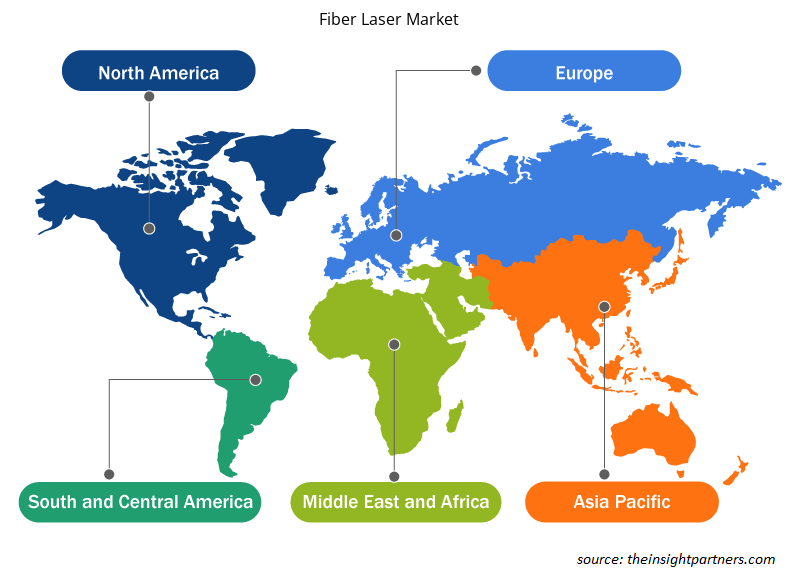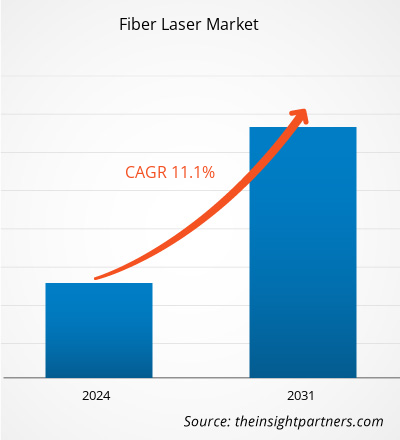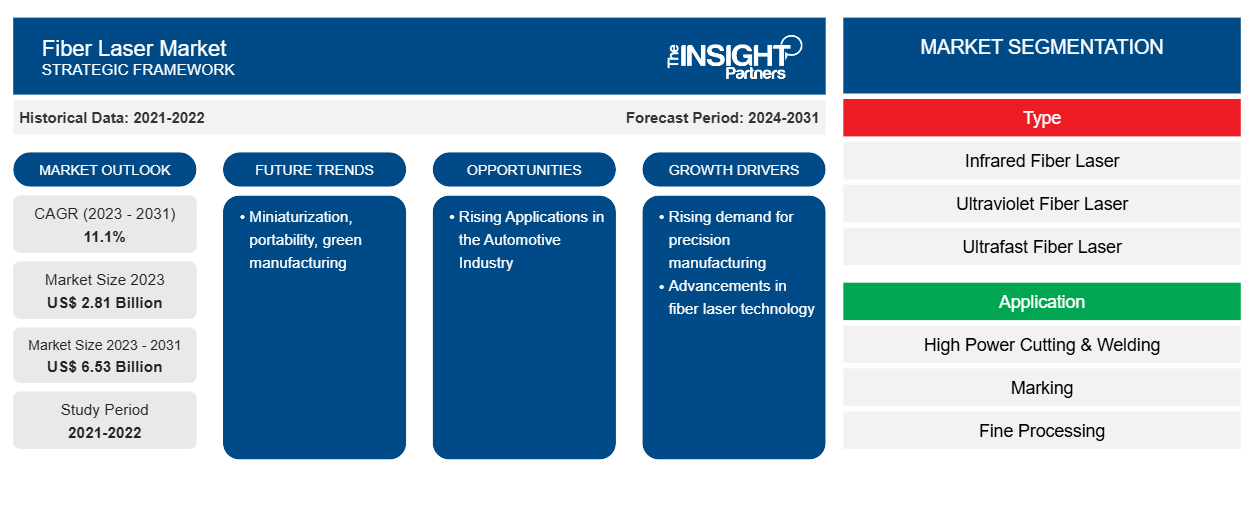Der Markt für Faserlaser soll von 2,81 Milliarden US-Dollar im Jahr 2023 auf 6,53 Milliarden US-Dollar im Jahr 2031 anwachsen. Der Markt wird zwischen 2023 und 2031 voraussichtlich eine durchschnittliche jährliche Wachstumsrate (CAGR) von 11,1 % verzeichnen. Miniaturisierung, Portabilität und umweltfreundliche Fertigung dürften weiterhin wichtige Trends auf dem Markt bleiben.
Faserlaser-Marktanalyse
Die Anwendungsgebiete für Schneidemaschinen für ultraharte Materialien nehmen in zahlreichen Branchen zu, darunter Halbleiter und Elektronik, Bergbau und Verteidigung. Möglich wurde dies durch die Integration modernster Technologien wie Faserlaser in die Schneidemaschinen für ultraharte Materialien. Man geht davon aus, dass Faserlasertechnologien eine außerordentlich hohe Nachfrage finden werden, nachdem ihr Preis durch Produktentwicklung und mehr Wettbewerbsfähigkeit auf dem Markt gesunken ist. Faserlasertechnologien sind nachweislich etwa dreißigmal schneller als elektrische Entladungsmaschinen.
Marktübersicht für Faserlaser
Faserlaser sind heutzutage weit verbreitet. Sie werden häufig in industriellen Umgebungen zum Schneiden, Markieren, Schweißen, Reinigen, Strukturieren, Bohren und für viele andere Aufgaben eingesetzt, da sie verschiedene Wellenlängen erzeugen können. Sie werden auch in anderen Branchen eingesetzt, darunter im Gesundheitswesen und in der Telekommunikation. Es gibt zahlreiche Anwendungen für Faserlaser im Fertigungssektor. CW-Faserlaser mit geringem bis keinem Wartungsbedarf sind ideal für bestimmte Anwendungen in der Schwerindustrie, bei denen Effizienz und Geschwindigkeit besonders wichtig sind. Beispielsweise eignen sich CW-Laser perfekt zum Laserschneiden, Laserbohren und Laserschweißen. Ein ideales Instrument für hochspezialisierte Schnitte in komplexen Formen ist ein gepulster Faserlaser. Solche Anwendungen treiben das Marktwachstum voran.
Passen Sie diesen Bericht Ihren Anforderungen an
Sie erhalten kostenlos individuelle Anpassungen an jedem Bericht, einschließlich Teilen dieses Berichts oder einer Analyse auf Länderebene, eines Excel-Datenpakets sowie tolle Angebote und Rabatte für Start-ups und Universitäten.
-
Holen Sie sich die wichtigsten Markttrends aus diesem Bericht.Dieses KOSTENLOSE Beispiel umfasst eine Datenanalyse von Markttrends bis hin zu Schätzungen und Prognosen.
Treiber und Chancen auf dem Faserlasermarkt
Steigende Nachfrage nach Präzisionsfertigung begünstigt den Markt
Die Mikrobearbeitung feiner Strukturen ist heute ein entscheidender Bestandteil der Massenfertigung in zahlreichen Branchen, darunter Unterhaltungselektronik, Medizintechnik und Automobilindustrie. Faserlaser hingegen haben sich zum Industriestandard für Lasermarkierung und Makrobearbeitung entwickelt. Die Fertigungslandschaft hat sich durch das Laserschneiden verändert, das den Unternehmen mehr Flexibilität, Geschwindigkeit und Präzision bietet. Mit der kontinuierlichen Weiterentwicklung der Technologie wird das Laserschneiden voraussichtlich einen größeren Einfluss auf die Art und Weise haben, wie Fertigung und Innovation in Zukunft erfolgen.micromachining is now a crucial component of
Zunehmende Anwendungen in der Automobilindustrie
In Bezug auf präzise, qualitativ hochwertige Schnitte wird der Einsatz von Laserschneidern in der Automobilindustrie allgemein als effektiv angesehen. Eine Vielzahl von Materialien kann mit Laserschneidern schnell und effektiv geschnitten werden. Dies führt zu besseren Fertigungszeiten und niedrigeren Kosten. Darüber hinaus bieten sie mehr Einheitlichkeit und Genauigkeit als herkömmliche Schneidtechniken, was die Anzahl von Fehlern und Mängeln im fertigen Produkt verringern kann. Da präzise Schnitte eine effektive Nutzung von Rohmaterialien ermöglichen, kann der Einsatz von Laserschneidern auch dazu beitragen, Materialabfälle zu minimieren. Aufgrund ihrer geringen Größe können Faserlaserschneider leicht in bestehende Produktionsprozesse integriert werden und benötigen weniger Stellfläche.
Segmentierungsanalyse des Faserlasermarktberichts
Wichtige Segmente, die zur Ableitung der Faserlaser-Marktanalyse beigetragen haben, sind Typ und Anwendung.
- Basierend auf dem Typ ist der Faserlasermarkt in Infrarot-Faserlaser, Ultraviolett-Faserlaser, Ultrakurzpuls-Faserlaser und sichtbare Faserlaser unterteilt. Das Segment der Infrarot-Faserlaser hatte 2023 den größten Anteil.ultrafast fiber laser, and visible fiber laser. The infrared fiber laser segment held the largest share in 2023.
- Basierend auf der Anwendung ist der Markt in Hochleistungsschneiden und -schweißen, Markieren, Feinbearbeitung und Mikrobearbeitung unterteilt.
Marktanteilsanalyse für Faserlaser nach geografischer Lage
Der geografische Umfang des Faserlaser-Marktberichts ist hauptsächlich in fünf Regionen unterteilt: Nordamerika, Asien-Pazifik, Europa, Naher Osten und Afrika sowie Süd- und Mittelamerika.
Der asiatisch-pazifische Raum hält 2023 einen bedeutenden Anteil am Faserlasermarkt. Die Region verfügt über ein bedeutendes Produktionszentrum und eine gut etablierte Automobilindustrie. Faserlaser finden in diesen Branchen wichtige Anwendungen für die Präzisionsfertigung und treiben so das Wachstum in der Region voran.
Regionale Einblicke in den Faserlasermarkt
Die regionalen Trends und Faktoren, die den Faserlasermarkt im Prognosezeitraum beeinflussen, wurden von den Analysten von Insight Partners ausführlich erläutert. In diesem Abschnitt werden auch die Marktsegmente und die Geografie des Faserlasermarkts in Nordamerika, Europa, im asiatisch-pazifischen Raum, im Nahen Osten und Afrika sowie in Süd- und Mittelamerika erörtert.

- Erhalten Sie regionale Daten zum Faserlasermarkt
Umfang des Faserlaser-Marktberichts
| Berichtsattribut | Details |
|---|---|
| Marktgröße im Jahr 2023 | 2,81 Milliarden US-Dollar |
| Marktgröße bis 2031 | 6,53 Milliarden US-Dollar |
| Globale CAGR (2023 - 2031) | 11,1 % |
| Historische Daten | 2021-2022 |
| Prognosezeitraum | 2024–2031 |
| Abgedeckte Segmente |
Nach Typ
|
| Abgedeckte Regionen und Länder |
Nordamerika
|
| Marktführer und wichtige Unternehmensprofile |
|
Dichte der Marktteilnehmer für Faserlaser: Auswirkungen auf die Geschäftsdynamik verstehen
Der Markt für Faserlaser wächst rasant, angetrieben durch die steigende Nachfrage der Endnutzer aufgrund von Faktoren wie sich entwickelnden Verbraucherpräferenzen, technologischen Fortschritten und einem größeren Bewusstsein für die Vorteile des Produkts. Mit steigender Nachfrage erweitern Unternehmen ihr Angebot, entwickeln Innovationen, um die Bedürfnisse der Verbraucher zu erfüllen, und nutzen neue Trends, was das Marktwachstum weiter ankurbelt.
Die Marktteilnehmerdichte bezieht sich auf die Verteilung der Firmen oder Unternehmen, die in einem bestimmten Markt oder einer bestimmten Branche tätig sind. Sie gibt an, wie viele Wettbewerber (Marktteilnehmer) in einem bestimmten Marktraum im Verhältnis zu seiner Größe oder seinem gesamten Marktwert präsent sind.
Die wichtigsten auf dem Faserlasermarkt tätigen Unternehmen sind:
- Active Fiber Systems GmbH
- IPG Photonics Corporation
- Fujikura Ltd.
- Konvergente Photonik
- Coherent, Inc.
- Jenoptik AG
Haftungsausschluss : Die oben aufgeführten Unternehmen sind nicht in einer bestimmten Reihenfolge aufgeführt.

- Überblick über die wichtigsten Akteure auf dem Faserlasermarkt
Neuigkeiten und aktuelle Entwicklungen zum Faserlasermarkt
Der Faserlasermarkt wird durch die Erhebung qualitativer und quantitativer Daten nach Primär- und Sekundärforschung bewertet, die wichtige Unternehmensveröffentlichungen, Verbandsdaten und Datenbanken umfasst. Nachfolgend sind einige der Entwicklungen auf dem Faserlasermarkt aufgeführt:
- Das Hochtechnologieunternehmen TRUMPF hat 80 Prozent der Anteile an der Active Fiber Systems GmbH (AFS) übernommen, einem auf Faserlaser spezialisierten Unternehmen mit Sitz in Jena. AFS entwickelt und fertigt Ultrakurzpuls-Lasersysteme und Faserlasersysteme, die vor allem in Wissenschaft und Forschung eingesetzt werden. Zu den Anwendungsgebieten zählen neben der Grundlagenforschung die Erzeugung von extrem kurzwelligem Licht mit hoher Kohärenz, die biomedizinische Bildgebung und die Materialbearbeitung. (Quelle: TRUMPF, Pressemitteilung, Februar 2022)
- IPG Photonics Corporation (NASDAQ: IPGP), der weltweit führende Anbieter von Faserlasertechnologie, wird auf der Battery Show vom 12. bis 14. September 2023 in Novi, Michigan, USA, neue und innovative Laserlösungen vorstellen. IPG wird eine neue Laserquelle mit einstellbarem Mode-Beam (AMB) vorstellen, die einen 3-kW-Singlemode-Laserstrahl im Kern erzeugen kann. Diese branchenweit einzigartige Steigerung der Singlemode-Leistung bietet beispiellose Geschwindigkeits- und Produktivitätsverbesserungen beim Batterieschweißen mit spritzerfreien Schweißgeschwindigkeiten, die bis zu 2-mal schneller sind als mit niedrigeren Kernleistungen. (Quelle: IPG Photonics Corporation, Pressemitteilung, August 2023)
Marktbericht zum Faserlaser: Umfang und Ergebnisse
Der Bericht „Marktgröße und Prognose für Faserlaser (2021–2031)“ bietet eine detaillierte Analyse des Marktes, die die folgenden Bereiche abdeckt:
- Faserlasermarktgröße und -prognose auf globaler, regionaler und Länderebene für alle wichtigen Marktsegmente, die im Rahmen des Berichts abgedeckt sind
- Markttrends für Faserlaser sowie Marktdynamik wie Treiber, Einschränkungen und wichtige Chancen
- Detaillierte PEST/Porters Five Forces- und SWOT-Analyse
- Analyse des Faserlasermarkts mit wichtigen Markttrends, globalen und regionalen Rahmenbedingungen, wichtigen Akteuren, Vorschriften und aktuellen Marktentwicklungen
- Branchenlandschaft und Wettbewerbsanalyse, einschließlich Marktkonzentration, Heatmap-Analyse, prominenten Akteuren und aktuellen Entwicklungen für den Faserlasermarkt
- Detaillierte Firmenprofile
- Historische Analyse (2 Jahre), Basisjahr, Prognose (7 Jahre) mit CAGR
- PEST- und SWOT-Analyse
- Marktgröße Wert/Volumen – Global, Regional, Land
- Branchen- und Wettbewerbslandschaft
- Excel-Datensatz
Aktuelle Berichte
Verwandte Berichte
Erfahrungsberichte
Grund zum Kauf
- Fundierte Entscheidungsfindung
- Marktdynamik verstehen
- Wettbewerbsanalyse
- Kundeneinblicke
- Marktprognosen
- Risikominimierung
- Strategische Planung
- Investitionsbegründung
- Identifizierung neuer Märkte
- Verbesserung von Marketingstrategien
- Steigerung der Betriebseffizienz
- Anpassung an regulatorische Trends























 Kostenlose Probe anfordern für - Markt für Faserlaser
Kostenlose Probe anfordern für - Markt für Faserlaser